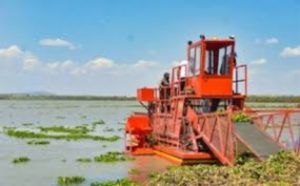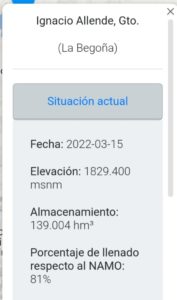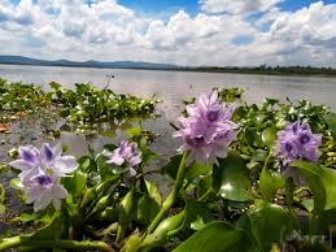Water lily “drowns” Allende Dam
News Category: News, Community News, and General Discussion
-
Long gone are the days when families and groups of friends enjoyed the sunsets and weekends at Presa Allende, inhabitants of the surrounding communities offered freshly caught fish in small boats, for the curious to get to know them or to prepare them for lunch. There were also stands selling fruit, fried food, corn, and drinks to spend a day enjoying the countryside. Now those places look desolate, there is only a green mantle covering Presa Allende: the water lily.
After 2 years of drought, the heavy rains of 2021 led the Begoña Dam (also known as Allende Dam) to exceed the NAMO level (Maximum Ordinary Water Level), the Laja River exceeded its capacity many times over and the dam captured millions of cubic meters of water. At the same time, the Laja River dragged small groups of water lilies that were in stagnant puddles, and it is unknown how they reached the river pools.
The water lily (Eichhornia Crassipes), a floating plant native to the Amazon Basin, was not part of the Mexican landscape more than 100 years ago. It is believed to have been introduced to the Xochimilco Canals at the end of the 19th century by Porfirio Díaz and his wife, Carmen Romero Rubio, in 1887. Its ornamental beauty prompted some of the country’s wealthiest families to introduce the species through the United States, where it arrived 13 years earlier, as a gift during a cotton exhibition held in 1884.
For many years, the water lily was used to beautify ponds and bodies of water; it is currently cataloged by the FAO as a weed, while the IUCN considers it one of the 100 most invasive species in the world.
Among the many studies that have been carried out on this plant, it was found that it is capable of absorbing heavy metals and pollutants, that is, its proliferation occurs more easily in contaminated sites.
The Cuenca de la Independencia (which includes the municipalities of Dolores Hidalgo, San Miguel de Allende, San Felipe, Ocampo, San Luis de la Paz, Doctor Mora, and San José Iturbide), also known as the Cuenca Alta del Río Laja, with an area of 7,000 km², presents serious problems of contamination with fluoride, arsenic and even radioactivity, as well as contamination of rivers and bodies of water.
Caminos de Agua has documented the contamination levels of the wells in the Independencia Basin for more than 10 years. Total groundwater extraction is one billion cubic meters per year, through some 3,000 wells, 85% of which is for agricultural export production, as documented by ‘La Jornada’ in 2021.

The Independencia Basin has serious water pollution problems in its wells and rivers, which makes its waters a breeding ground for the proliferation of this invasive species.
The aquatic lily is not the problem, but only a symptom of the poor management of the Upper Laja River basin, which translates into a regional problem that requires the articulation of all the parties involved in order to address the various causes that give rise to the eutrophication of the Ignacio Allende Dam.
Alejandro Castro, Director of Environment and Sustainability referred this administration has led and will lead the organization of the efforts of the different stakeholders to find short, medium, and long term solutions. “All civil society, non-governmental organizations, research centers, and academia will be convened in order to generate a long vision plan.”
“CLEANUP” OF THE ALLENDE DAM AND CURRENT AFFECTATION.
The Directorate of Environment and Sustainability reported that it has conducted frequent studies of multispectral satellite images, using advanced processing techniques. The satellite image available on March 11, 2022, shows an area of approximately 450 hectares affected by water lilies (in December 2021 it was estimated that 300 hectares were affected). This figure may vary according to different factors, but it is very approximate.
On March 7, a “harvesting” machine arrived in San Miguel de Allende to remove the water lilies, due to the apathy of CONAGUA and the Government of Celaya.

The lily harvesting machine removes approximately 13 hectares per month and is in a trial period to calculate the removal rate and compare it against the growth rate. Compared to the current situation, it would take 34 months to complete the removal of the water lily (without taking into account the growth rate).
For the time being, the extracted lily is left to dry on the margins of the dam until degradation. The water lily plant is up to 95% water, and when it is out of the water, it loses a large part of its weight over a period of 7 days.
After this period, the idea is to transfer it to a final disposal site; however, for the time being, it is placed on the banks of Presa Allende.
Although there are several uses for this aquatic weed around the world, including paper production, biofuels, and biofertilizers, the recommendation of state and federal agencies that have fought this pest in other places is to work from an approach that views the water lily as a pest that must be eradicated.
As this plant is also used to remediate contaminated bodies of water, the Directorate of Environment and Sustainability intends, prior to its use, to carry out scientific studies to rule out the existence of any possible contaminant. Once any risk to health and the environment from its use as a raw material has been ruled out, the department plans to use it as an organic fertilizer to nourish the eroded soils of rainfed producers, as well as its possible use as an input in the brick industry and other applications that are still in the experimental phase.
WASTE DISCHARGES RESPONSIBLE FOR PROLIFERATION: CONAGUA
Vicente Zepeda, head of CONAGUA Guanajuato, pointed out that in the Allende Dam the waste discharges are practically the basis for the growth of the water lily; in addition, in the last 2 years there was scarce storage, the water that entered was practically residual. However, so far no tangible actions have been taken to contain the production of water lilies.
In this regard, the Directorate of Environment and Sustainability indicated that they have begun to carry out inspections and pay attention to reports of illegal discharges. It is worth mentioning that in the last 4 years the watershed has been overexploited with agriculture, livestock and above all uncontrolled and uncontrolled real estate growth derived from more than 100 new subdivisions authorized with very ambiguous and lax norms.
DISTRICT 85 AT RISK
Presa Allende belongs to irrigation District 85 and benefits some 2,000 producers of garlic, oats, zucchini, barley, onions, cabbage, beans, chickpeas, jicama, lettuce, watermelon, wheat, and carrots, most of which are located in Celaya and Comonfort.
Every year the Allende Dam sends between 40 and 110 million cubic meters of water to Bajío producers; however, due to the problem of water lilies, storage has been compromised. As of March 15, the Allende Dam was 81% full with respect to the NAMO.

The Municipal Government urged the federal authorities to consolidate an action plan to address the problem and join efforts to benefit the fishermen of San Miguel de Allende and the farmers of the Bajío.
-


Leave a Reply